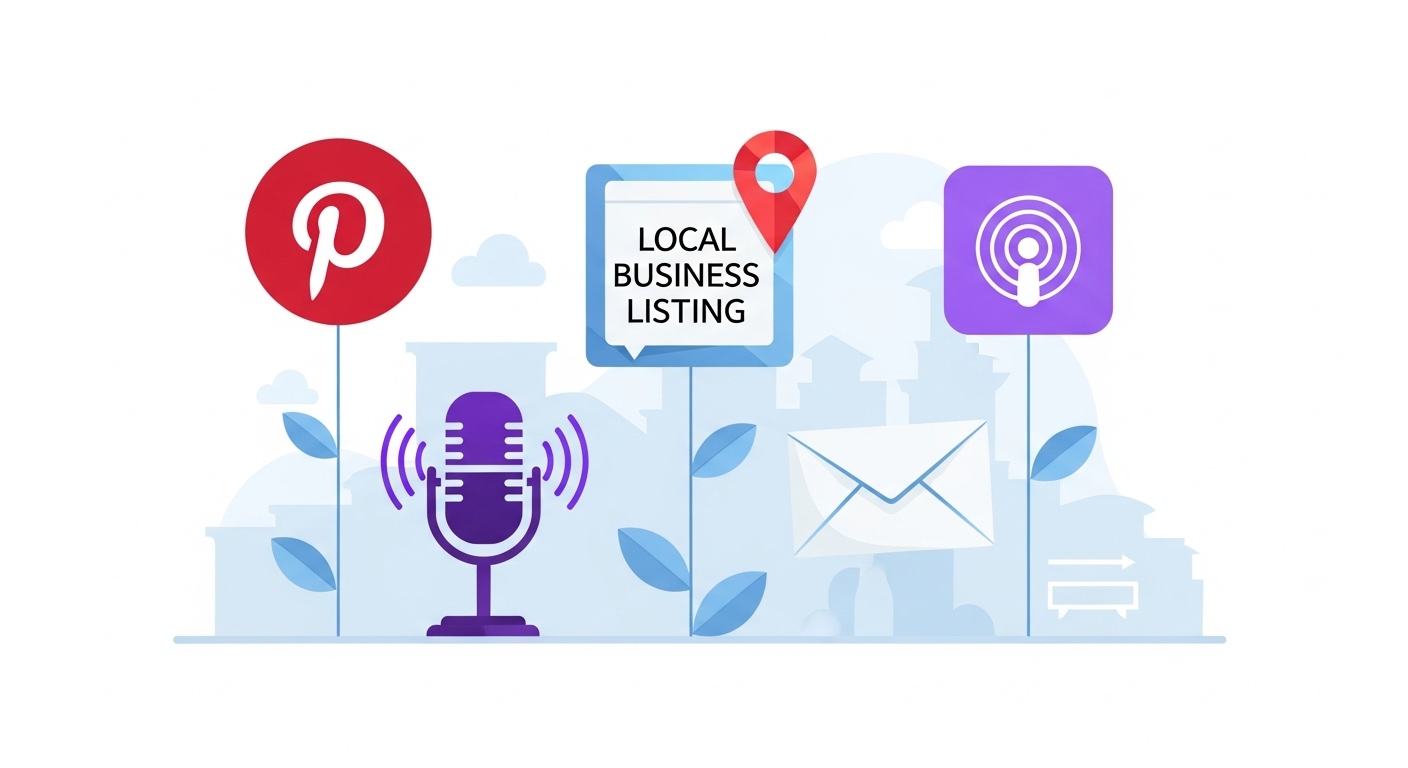Nepal Digital Marketing: Untapped Avenues & Diversification
Executive Summary: Navigating Nepal’s Saturated Digital Market
This report provides a strategic blueprint for businesses in Nepal to overcome the challenges of digital marketing saturation by diversifying their approach. While platforms like Facebook and YouTube have undeniable reach, their crowded nature, coupled with prevalent trust and digital literacy gaps, necessitates a shift towards alternative, trust-building channels. The analysis details the untapped potential of platforms like Pinterest for visual discovery, the strategic necessity of local listing sites for building credibility, the burgeoning video podcast scene as a medium for authentic long-form content, and the high-ROI, personalized nature of email marketing. By adopting a multi-channel, localized, and trust-focused strategy, businesses can secure a competitive edge and achieve sustainable digital growth.

Part 1: The Foundations of a Digital Shift in Nepal
1.1. The Current Digital Landscape: An Overview of a Saturated Environment
The digital marketing landscape in Nepal is characterized by rapid growth and a paradoxical concentration of user activity. As of early 2025, the country had a robust user base of 16.5 million internet users, representing a significant internet penetration rate of 55.8% of the total population. This growth is largely driven by a mobile-first culture, with a majority of popular social media platforms optimized for and experienced primarily through mobile devices. The widespread adoption of smartphones is a key factor enabling businesses to reach potential customers at a fraction of the cost of traditional media.
However, a closer examination of user data reveals an overwhelming concentration of activity on a few key platforms. Data from August 2025 shows that Facebook holds a staggering 87.08% market share, a near-monopoly that dwarfs all other platforms. The next closest competitors are Twitter at 6.13% and YouTube at 5.46%, with platforms like Instagram (0.53%) and Pinterest (0.12%) holding a minuscule share of the market. This data is a powerful visual representation of the crowded nature of the most popular digital spaces.
The following table, derived from Statcounter Global Stats, provides a clear overview of the social media market share in Nepal as of August 2025.
| Platform | Percentage Market Share |
|---|---|
| 87.08% | |
| 6.13% | |
| YouTube | 5.46% |
| 0.63% | |
| 0.53% | |
| 0.12% |
This extreme concentration creates a significant challenge for businesses, what can be described as a “winner’s curse” for brands. The high user presence on platforms like Facebook naturally attracts an equally high number of businesses, resulting in intense competition for consumer attention. Businesses are now “flooded with content from competitors” who are adept at creating content to “hook them in less than 10 seconds“. The sheer volume of this content creates a saturated feed for the user, making it increasingly difficult for businesses to achieve meaningful organic reach. This dynamic often forces brands to resort to paid or “boosted posts” that may not deliver a strong return on investment. This paradox illustrates that while the audience is undoubtedly present, the competition for their attention makes a singular focus on mainstream social media an unsustainable strategy for many, thereby justifying the need to explore alternative channels.
1.2. The Barriers to Digital Marketing: Why Trust and Context Matter
Beyond the issue of saturation, a deeper analysis reveals fundamental barriers within Nepal’s digital ecosystem that limit the effectiveness of traditional marketing approaches. The single most critical challenge is a pervasive digital trust gap. A study found that a significant portion of consumers are still reluctant to shop online due to concerns about “product authenticity, fraudulent activity, and the lack of trustworthy return policies“. This hesitation is a substantial obstacle, with 48% of respondents citing these worries as a reason they are reluctant to make online transactions. This lack of trust makes conventional, impersonal advertising channels, such as display ads, less effective, as they lack the credibility needed to convert a hesitant buyer. The research reinforces that trust must be earned through authentic content, not simply purchased through advertising.
The challenges are compounded by gaps in digital infrastructure and literacy. While urban areas boast high internet penetration, a considerable portion of the population in rural regions still contends with “major connectivity issues,” with many relying on slower 2G access. This infrastructure disparity limits the reach of digital campaigns that rely on high-quality visuals or consistent connectivity. Similarly, a “sizable section of Nepali customers and small businesses” lack sufficient digital literacy, which can prevent them from engaging with complex online marketplaces. For small and medium-sized businesses (SMEs), these issues are further exacerbated by budget limitations, as they often cannot afford the “expensive software or sponsored ads” needed to compete with larger brands. The shortage of trained digital marketing professionals, particularly outside major cities, adds another layer of difficulty for businesses seeking to build an effective online presence.
The cumulative effect of these barriers means that a pure focus on mass reach is an ineffective strategy. The fundamental requirement for success is to prioritize building credibility and social proof. This suggests a fundamental recalibration of marketing priorities: instead of focusing on vanity metrics like impressions, businesses should measure success by metrics that indicate trust, such as review volume, positive sentiment, and direct word-of-mouth referrals. The strategies outlined in this report are structured around this trust-first paradigm.
Part 2: The Evolving Ecosystem of Alternative Marketing Channels

2.1. The Power of Visual Discovery: A Deep Dive into Pinterest
With a market share of just 0.12%, Pinterest represents a largely unexplored and highly strategic opportunity for early adopters in Nepal. It operates not as a traditional social network built on a chronological feed, but rather as a visual discovery and search engine. Users come to the platform with an open mind and a high intent to find and plan for products and ideas. This makes Pinterest a “long-term growth” tool that can work “in the background” for a business, a stark contrast to the continuous, high-volume content creation required for platforms like TikTok and Instagram.
A strategic Pinterest system can be highly effective, as demonstrated by the case study of a small business owner who, within two months, grew her monthly views from a few hundred to 10,000 and secured her “first tracked direct sale from Pinterest“. This example proves that Pinterest can become a sustainable sales channel. The effectiveness of this platform for businesses facing content burnout from the “short-term grind” of other social media is rooted in its business model. Because Pinterest functions as a search engine, a Pin created today can continue to generate traffic for months or even years, rewarding evergreen, high-quality content rather than fleeting viral trends. This approach shifts a business’s marketing efforts from a time-intensive, reactive strategy to a scalable, passive asset-building one. For SMEs with limited resources, this represents a sustainable model for generating inbound traffic and sales without the significant and continuous time investment required by other channels.
For a Nepali business seeking to leverage this platform, the following steps are recommended:
- Set up a free business account, which provides access to powerful tools like analytics and custom audience insights that are not available on a standard personal account.
- Integrate e-commerce platforms. Businesses with Shopify or WooCommerce shops can easily connect their product catalogs to Pinterest, automatically turning their products into “shoppable Pins” that link directly to their website.
- Develop a strategic content plan. Focus on creating high-quality, vertical images and videos with a recommended 2:3 aspect ratio. Optimize for search by using descriptive keywords in both Nepali and English. The most effective content on Pinterest is often not a hard sell, but rather informational “how-tos, expert tips, trend roundups, inspirational photos or videos“.
2.2. Building Local Trust: The Strategic Importance of Business Listing Sites
In a market defined by a trust gap, local business directories serve a critical function beyond simple search engine optimization. They are a foundational tool for building third-party validation and credibility with potential customers. These platforms serve as a modern equivalent of the traditional Yellow Pages, and several prominent Nepalese directories are effectively filling this role.
The following table provides an overview of key business listing directories in Nepal and their strategic value.
| Directory Name | Key Features | Value Proposition for Businesses |
|---|---|---|
| YellowPages Nepal | Free listings, high Domain Authority (DA 32) | Improves business reach and online visibility with a free, well-established platform. |
| Inquiry Nepal | Manual verification, SEO optimization, storytelling features, premium listings | A “trusted and verified” directory that directly addresses the trust gap. |
Listings are manually verified and optimized for search engines like Google, Yahoo, and Bing, helping businesses get found and build a high-quality reputation.
JantaReview Nepal
Business reviews, local marketing, discussion forum
Builds community-driven trust through a platform that provides reviews and a forum for discussion. Also offers local marketing and advertising services.
BizDire Nepal
Free and paid listings, categorized by location and industry, verified businesses
Provides a structured platform for businesses to increase their online visibility and receive business leads. A focus on verified listings helps build confidence.
The strategic value of these platforms lies in their ability to act as a signal of legitimacy. A business’s presence on a manually verified directory like Inquiry Nepal serves as a form of external validation that helps to bridge the trust gap. The presence of customer reviews further amplifies this social proof, making potential customers more comfortable in contacting or transacting with a business they discovered online. The effectiveness of this approach is amplified by the fact that the marketing effort is a low-cost, high-leverage move. It suggests that a business’s first step in digital marketing should not be an aggressive ad campaign but rather the foundational work of establishing and optimizing its local presence. This “low-hanging fruit” strategy directly addresses a core psychological barrier to online commerce in Nepal.
For an optimized listing, businesses should ensure consistent Name, Address, and Phone number (NAP) details across all platforms, utilize location-based keywords in both Nepali and English, and actively encourage customer reviews to build credibility.
The Long-Form Advantage: Podcasting and Video Content Marketing
In contrast to the dominance of short-form video on platforms like TikTok and Instagram Reels, a new and significant trend is the rise of long-form, video podcasts. The video podcast scene in Nepal has “exploded” due to a consumer craving for “deeper,” “more substantial,” and “prolonged” content that offers a “free-flowing conversational format” previously absent from the media landscape.
The appeal of this medium lies in its authenticity. Podcasts like ‘On Air With Sanjay’ and ‘Paradygm Podcasts’ have found success by entertaining extensive and intimate conversations with guests, appealing to an audience that is growing tired of “fluffy and forgettable material”. This trend is not merely a passing fad; it is a reflection of a maturing digital consumer who seeks genuine connection and in-depth information. By consuming this type of content, the audience is actively engaging with the material, not just passively scrolling.
This presents a unique opportunity for businesses to engage with a highly attentive and loyal audience through strategic brand partnerships.
- Sponsorship Models: Brands can partner with podcasts for host-read ads or sponsorships, which are typically based on a flat fee or a CPM (cost per mille/thousand downloads) model. Examples of successful brand partnerships include Turkish Airlines, Vianet Communication, and NIU with ‘On Air With Sanjay’.
- The Power of Niche: Podcasts can cater to highly specific, niche audiences, such as ‘Period Kaa Kura’ for gender issues, ‘The Doers Nepal’ for entrepreneurship, or ‘Nepali Paisa’ for finance. This allows brands to target a specific audience with unparalleled precision and authenticity.
- Cost-Effectiveness: The pricing models for sponsorship are transparent and scalable, making this a viable option for mid-size businesses.
The rise of video podcasts is a direct counter-trend to the short-form video dominance, signaling a bifurcation of consumer behavior. While many users seek quick, entertaining content, a segment of the audience desires more meaningful material. This creates a new, highly valuable avenue for trust-building and authority marketing. For brands, this represents a shift from competing for fleeting attention to sponsoring or producing content that establishes them as a thought leader, cultivating genuine brand loyalty. This move from “selling” to “storytelling” is a long-term play that is crucial given Nepal’s existing trust issues.
Personalization at Scale: The Untapped Potential of Email Marketing
Despite its maturity as a channel, email marketing is noted as an “underutilized strategy in Nepal” that offers a direct and personal avenue for businesses to nurture customer relationships and encourage repeat purchases. For sectors like e-commerce, travel agencies, and education, targeted email campaigns can be highly effective.
While Nepal may not have specific email-related laws akin to the GDPR or CAN-SPAM, the existing Electronic Transactions Act and Consumer Protection Act provide a legal framework that impacts how businesses can conduct email marketing. To ensure long-term success and ethical practices, a business should adopt global best practices, which include:
- Obtaining Explicit Consent (Opt-in): Users must actively agree to receive marketing communications. This practice builds trust and improves engagement.
- Providing an Easy Opt-out Mechanism: Every marketing email must include a clear, easy-to-use unsubscribe link. This is a fundamental right for users and a best practice that reduces spam complaints.
- Transparency and Data Security: Businesses should have a clear privacy policy that explains how user data is collected and used, and they must protect their subscriber lists from misuse.
A successful email campaign requires building a compliant, opt-in list; crafting compelling headlines and personalized content; ensuring mobile-friendly design; and tracking key metrics like open rates, click-through rates, and conversion rates to optimize future campaigns.
Part 3: Advanced Strategies for Competitive Edge
From Mass to Micro: A Nuanced Approach to Influencer Marketing
Influencer marketing is a dominant trend in Nepal, but its most effective application is shifting. Instead of partnering with “big-name personalities,” businesses are finding greater success with “micro-influencers with tight-knit loyal followings”. These creators offer a level of authenticity and personal connection that paid ads simply cannot replicate.
A research study on the Nepalese fashion market provides a critical insight: “credibility and expertise significantly impact consumer purchase intention,” while mere trustworthiness and authenticity do not. This suggests that a recommendation from an influencer who is a recognized expert in a specific domain (e.g., a skincare advocate for beauty products, a fashion designer for couture) carries more weight and generates a higher return on investment than a simple, authentic post from a celebrity. This finding reframes influencer marketing in Nepal from a mass-reach play to a precision-targeted, trust-building exercise.
The following table provides a breakdown of influencer tiers, which can help businesses with budget constraints effectively navigate this landscape.
| Influencer Tier | Follower Count Range | Primary Value Proposition | Estimated Cost Range (NPR) |
|---|---|---|---|
| Mega | 1M+ | Broad, mass reach; often associated with celebrities | Rs150,000+ |
| Macro | 100K-1M | Wider reach within a specific niche; often seen as highly professional | Varies widely, can be substantial |
| Micro | 10K-100K | Niche expertise, high engagement, strong community trust | Rs1,500 to Rs150,000 |
| Nano | 1K-10K | Hyper-local or hyper-niche, very high engagement, peer-to-peer influence | Often barter or free product deals |
The affordability of campaigns with micro-influencers, which can range from Rs1,500 to Rs150,000, makes this an accessible option for companies of all sizes and a “preferred choice” for many. By focusing on a micro-influencer whose specialized knowledge generates credibility, businesses can achieve a higher return on investment than with a more expensive, less targeted celebrity endorsement. This approach empowers SMEs to compete effectively by focusing on finding the right niche expert rather than chasing the largest audience.
Social Commerce and Transactional Trust
A notable trend in Nepal is the rise of social commerce, where a “surprising portion of the population… prefers to shop directly from Facebook or Instagram”. Platforms have facilitated this shift with features like “shoppable posts and in-app checkout”. This provides a seamless buying experience that leads to “fewer drop-offs and more impulse buys”.
This trend can be seen as a direct response to the market’s trust issues and digital literacy gaps. By minimizing the number of steps and keeping the transaction within a familiar and trusted environment, businesses can overcome the friction of requiring users to visit an external website, a task many find “boring” or “difficult”.
Major e-commerce companies like Daraz and Sastodeal have successfully built platforms that address these trust issues through their established scale and reputation. Daraz, for instance, offers “marketing solutions” and “affiliate programs” that allow brands to leverage its established consumer trust and high-intent audience. However, even with these advancements, the persistence of Cash on Delivery (COD) as a preferred payment method underscores that a significant trust gap remains and that businesses must continue to work to bridge this divide to achieve scale and operational efficiency.
Part 4: A Framework for Strategic Implementation
Developing a Holistic, Diversified Marketing Plan
A successful digital marketing strategy in Nepal should not be a “scattergun” approach but rather a synergistic, sequential framework that directly addresses the unique consumer behavior and challenges present in the market.
The Nepali digital consumer is mobile-first and wary of online transactions due to a lack of trust. They also exhibit a dual preference for both quick gratification from short-form content and in-depth information from long-form content. A single marketing channel cannot address all these behaviors; therefore, a layered approach is required.
The marketing funnel should be structured as follows:
- The Foundational Layer (Trust & Local Search): The first step for any business should be to establish a strong local presence on business listing sites like Inquiry Nepal and YellowPages Nepal. This foundational work builds credibility and improves local SEO, making it easier for nearby customers to find and verify the business. Obtaining a “verified badge” on a manually reviewed site prepares the ground for future marketing efforts.
- The Discovery & Authority Layer (Pinterest & Podcasting): Once a business has a credible foundation, it should layer on long-term, passive marketing channels. For visually-driven brands and e-commerce, a strategic Pinterest presence can serve as a passive engine for inbound traffic, attracting high-intent users who are in the planning or discovery phase. For service-based or B2B businesses, sponsoring or creating a video podcast can establish brand authority and thought leadership, targeting a highly engaged audience with a deeper, more personal connection.
- The Conversion & Loyalty Layer (Influencer & Email): The final layer uses targeted channels for direct sales and retention. Businesses should partner with niche micro-influencers whose expertise will build credibility and drive conversions by leveraging their specialized knowledge. Simultaneously, building a clean, opt-in email list is essential to nurture leads, provide exclusive offers, and cultivate long-term customer relationships.
This layered approach ensures that each channel is not operating in a silo but is working to support the next, with trust-building at its core. A consumer who finds a business on a local listing site may later see a sponsored podcast from that same brand, reinforcing their sense of legitimacy and credibility. This framework moves beyond a list of “alternative tools” and provides a strategic roadmap for holistic digital growth in a challenging market.
Conclusion: A Path to Sustainable Digital Growth
The digital marketing landscape in Nepal is evolving rapidly, moving beyond the simple metrics of reach and impressions to a more nuanced focus on credibility and engagement. The saturation of conventional social media platforms and the deep-seated trust gap among consumers present significant challenges. However, they also create a unique opportunity for businesses that are willing to diversify their strategies.
The analysis in this report demonstrates that the path to sustainable digital growth is not about throwing more resources at saturated platforms but about strategically investing in less-crowded channels that prioritize authenticity, trustworthiness, and a deep understanding of the Nepalese digital consumer. By establishing a strong foundational presence on local business listing sites, cultivating a long-term discovery strategy on platforms like Pinterest, building authority through video podcasts, and nurturing customer relationships with personalized email marketing, a business can create a resilient and effective digital ecosystem. The strategic and affordable use of niche micro-influencers further amplifies this effort, enabling even SMEs to compete effectively by leveraging specialized expertise over mere fame. The future of digital marketing in Nepal belongs to those who embrace this diversified, trust-centric approach.
📚 For more insights, check out our complete digital marketing guide.


